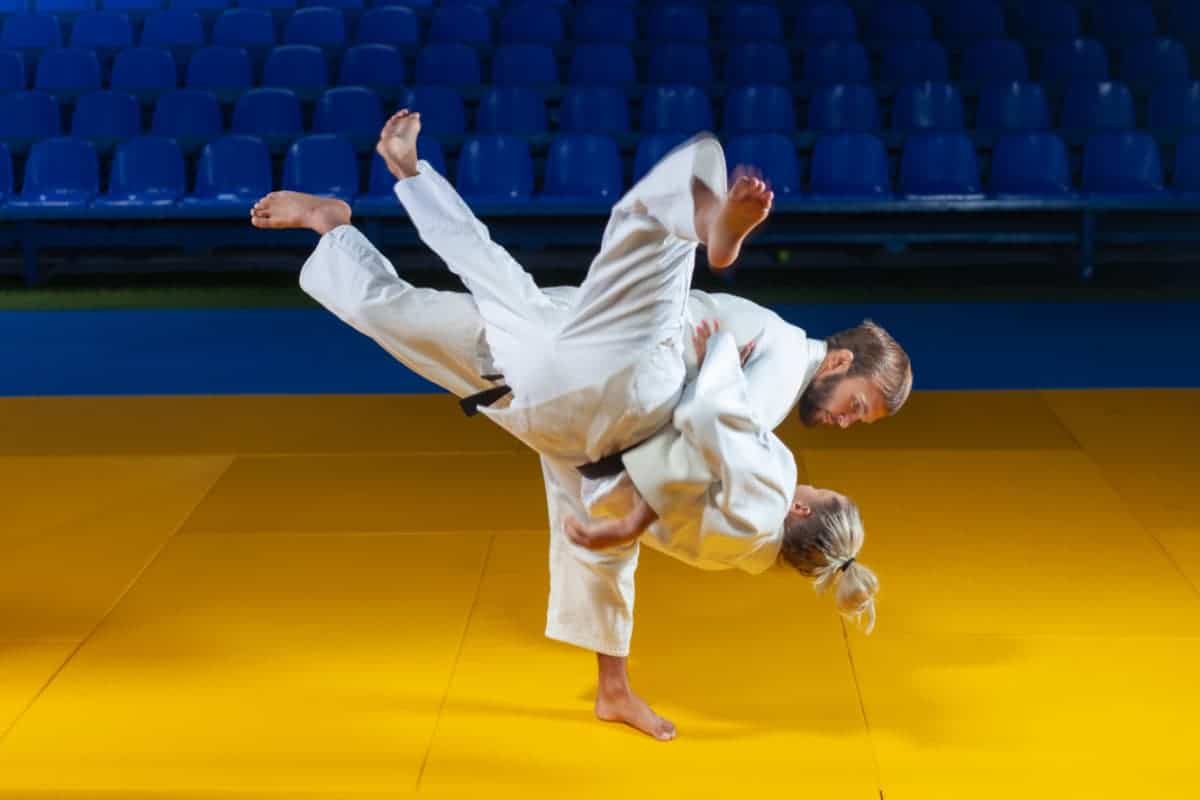Many people wonder if they should know all 68 different throws in judo. It takes a lot of practice and focus to master them all, and a good judo throw doesn’t come easily. If you don’t know how to execute it correctly, you can wind up being thrown to the ground instead!
A person needs to know five distinct throws as a beginner. However, more experienced judoka will have more than twenty distinct throws in their repertoire, and world-class competitors may have as many as fifty.
So, how many judo throws are you interested in learning about? No matter how many judo throws you aim to master, this article will teach you things you need to know about the basics of judo throws and the various judo throwing techniques. Keep on reading!
Table of Contents
Judo Throws and Techniques
Judo throws, or nage waza, have five different technique groups:
- Te waza
- Koshi waza
- Ashi waza
- Ma sutemi waza
- Yoko sutemi waza
Experts and instructors recommend that you learn at least one throw per group. We’ll discuss these throws and techniques in more detail below:
Judo Techniques – Waza
Let’s start by becoming familiar with the other judo waza groups before diving into the many throw techniques that judo offers. Judo techniques or waza can be put into three major groups:
- Throwing techniques (nage waza)
- Grappling techniques (katame waza)
- Body-striking techniques (atemi waza)
Katame waza are techniques that only limit the opponent’s mobility. Atemi waza, on the other hand, are techniques designed to hit the opponent in their vital spots. Because of the inherent risk involved, competitors are prohibited from using atemi waza during competitions.
Throwing Techniques – Nage Waza
Nage waza comes in many different forms, and their goal is to throw an opponent to the ground by throwing them off balance. It has two main types: standing techniques (tachi waza) and sacrifice techniques (sutemi waza):
Tachi Waza
Tachi waza are techniques performed from a standing posture. It is divided into three groups:
- Hand techniques (te waza)
- Hip techniques (koshi waza)
- Foot techniques (ashi waza)
Te Waza
Te waza are techniques in which the opponent is thrown using the hands or arms and performed from a standing position. To make the opponent lose balance, the person executing the technique (tori) first uses Tai-sabaki (body shifting or body control), followed by a dynamic throw.

There are 16 different techniques under this group:
- Kata Guruma
- Morote Seoinage
- Tai Otoshi
- Morote Gari
- Ippon Seoinage
- Sukuinage
- Obi Otoshi
- Kibisu Gaeshi
- Kuchiki Taoshi
- Morote Gari
- Sumi Otoshi
- Yama Arash
- Uki Otoshi
- Uchimata Sukashi
- Seoi Otoshi
- Obi Tori Gaeshi
There are many terms and techniques to remember, but what better way to learn than to watch someone else do them? Check out this video:
Koshi Waza
Koshi waza are quick throws with the hip as the pivot point. After putting an opponent on your hip, you execute the technique with a leg sweep technique, a shoulder throw, or both.
There are only ten techniques under this group:
- O Goshi
- Sode Tsurikomi Goshi
- Hane Goshi, Harai Goshi
- Tsurikomi Goshi
- Koshi Guruma
- Tsuri Goshi
- Uki Goshi
- Ushiro Goshi
- Utsuri Goshi
Watch this video to see how these techniques are performed:
Ashi Waza
Ashi waza are techniques that use the foot or the leg to sweep or trip the opponent. The tori attacks the opponent’s leg to trip them and throw them off balance.
This group has the most number of techniques which include the following:
- De Ashi Harai
- Hiza Guruma
- Sasae Tsurikomi Ashi
- O Soto Gari
- O Uchi Gari
- Ko Soto Gari
- Ko Uchi Gari
- Okuri Ashi Harai
- Uchi Mata
- Ko Soto Gake
- Ashi Guruma
- Harai Tsurikomi Ashi
- O Guruma
- O Soto Guruma
- O Soto Gaeshi
- O Soto Otoshi
- Tsubame Gaeshi
- O Uchi Gaeshi
- Hane Goshi Gaeshi
- Harai Goshi Gaeshi
- Uchi Mata Gaeshi
Here’s a video with some of the most commonly used techniques under this group:
Sutemi Waza
Sutemi waza are techniques in which the person doing the technique (tori) wraps the person being attacked (uke) around his own body and falls with him. It has two groups: rear sacrifice techniques (ma sutemi waza) and side sacrifice techniques (yoko sutemi waza).
The Kodokan Judo Institute lists 21 techniques in this category. Of these, yoko sutemi waza has 16 and ma sutemi waza has only 5.
Ma Sutemi Waza
Because the tori must “sacrifice” himself by falling onto his back to perform the throw, ma-sutemi-waza is sometimes referred to as the rear sacrifice technique.
The five techniques under this group are:
- Tomoe Nage
- Sumi Gaeshi
- Hikikomi Gaeshi
- Tawara Gaeshi
- Ura Nage
You can watch the demonstration of these techniques here:
Yoko Sutemi Waza
For the techniques in yoko sutemi waza, the throw is performed by the tori falling on his side. This is sometimes referred to as the side sacrifice technique.
The 16 techniques under this group are:
- Yoko Otoshi
- Tani Otoshi
- Hane Makikomi
- Soto, Makikomi
- Uchi Makikomi
- Uki Waza
- Yoko Wakare
- Yoko Guruma
- Yoko Gake
- Daki Wakare
- O Soto Makikomi
- Uchi Mata Makikomi
- Harai Makikomi
- Ko Uchi Makikomi
- Kani Basami
- the prohibited waza called Kawazu Gake
Here is a video demonstrating this technique:
Conclusion
Ultimately, there is no right or wrong number of throws to study. It all comes down to what you want from judo.
Whether you’d like to practice your favorite throwing techniques repeatedly, or mix up your throws so that your opponents don’t get used to the same movements each time, there is no shortage of options!

